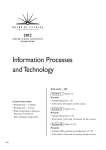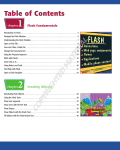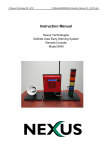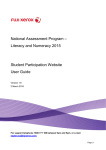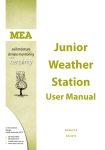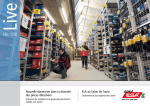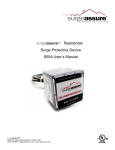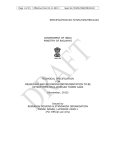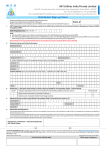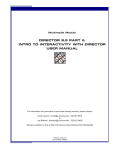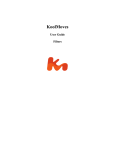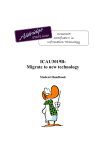Download Information Processes and Technology
Transcript
2012 H I G H E R S C H O O L C E R T I F I C AT E E X A M I N AT I O N Information Processes and Technology Total marks – 100 Section I General Instructions • Reading time – 5 minutes • Working time – 3 hours • Write using black or blue pen Black pen is preferred • Draw diagrams using pencil Pages 2–8 20 marks • Attempt Questions 1–20 • Allow about 40 minutes for this section Section II Pages 9–12 40 marks • Attempt Questions 21–24 • Allow about 1 hour and 10 minutes for this section Section III Pages 14–20 40 marks • Attempt TWO questions from Questions 25–28 • Allow about 1 hour and 10 minutes for this section 1300 Section I 20 marks Attempt Questions 1–20 Allow about 40 minutes for this section Use the multiple-choice answer sheet for Questions 1–20. 1 Which protocol would be most appropriate to send a client ID and password to an online banking system? (A) Secure Socket Layer (SSL) (B) File Transfer Protocol (FTP) (C) Hypertext Transfer Protocol (http) (D) Portable Document Format (PDF) 2 Which of the following diagrams best represents digital to analogue conversion? (A) sender modem receiver (B) sender modem receiver (C) sender modem receiver (D) sender modem receiver –2– 3 In which of the following documents will potential costs associated with a new system be included? (A) Gantt chart (B) User manual (C) Process diary (D) Feasibility report 4 The diagram shows a portion of a network. Awaiting Copyright What term is used to describe Computer 1 in the diagram? (A) Fat client (B) Web server (C) Thin client (D) Mail server 5 Which of the following describes the organisation of hypermedia? (A) Nodes and links (B) Files and records (C) Online and offline storage (D) Direct and sequential access to data 6 Which of the following best describes handshaking between two communication devices? (A) Modulation of a signal (B) Process to encrypt a message (C) Establishment of an agreed protocol (D) Detection and correction of transmission errors –3– 7 Which of the following transmission media only allows transmission if the sender and the receiver are in line of sight? (A) Optic fibre (B) Microwave (C) Coaxial cable (D) Twisted pair 8 The cable shown in the diagram carries digitised data. Awaiting Copyright What type of waves are carried by this cable? (A) Radio waves (B) Microwaves (C) Sound waves (D) Light waves –4– 9 Four network topologies are shown. KEY Node Server Transmission medium Terminator 1 2 3 4 Which row in the table correctly identifies the types of network topologies shown? 10 1 2 3 4 (A) star bus ring hybrid (B) ring star bus hybrid (C) ring star hybrid bus (D) star hybrid bus ring The following 8-bit ASCII character and a parity bit were transmitted without error. ASCII character Parity bit 00110010 1 Which of the following would result in an error message if sent using the same parity? (A) 01010111 1 (B) 01100101 1 (C) 10111000 0 (D) 00010010 0 –5– 11 A new database system for the management of records has been implemented in a doctors’ surgery. Paper records will continue to be used until all staff are trained and confident in using the new system. Which conversion method is being used? (A) Direct (B) Parallel (C) Phased (D) Pilot 12 The table shows a partial data dictionary from a database. Field name Size Data type IDnum 10 number Surname 20 text Firstname 20 text Phone 10 text What is the approximate amount of memory needed to store 10 000 records in this database? (A) 60 Kb (B) 600 Kb (C) 6000 Kb (D) 60 000 Kb 13 Users have recognised that there are problems with an existing information system. Which of the following would help in finding the cause of the problem? (A) Identifying participants (B) Producing a new Gantt chart (C) Analysing the system (D) Retraining participants to use the system –6– 14 Within a school database, which of the following describes the relationship between data in a student table and data in a subject table? (A) One to one (B) One to many (C) Many to one (D) Many to many 15 In free text search, the * symbol can be used to replace 0 to 7 characters in a word, not including white space. Which of the following searches would locate all three words ‘hypermedia’, ‘multimedia’ and ‘hypertext’? (A) media* OR hyper* (B) multi* OR hyper* (C) *multi AND *text (D) *media AND *hyper 16 This image shows detail of an emerging technology used in luggage tags to track items being transported from the check-in area at an airport to different aircraft. Awaiting Copyright What technology is this? (A) Optical Character Recognition (B) Radio Frequency Identification (C) Magnetic Ink Character Recognition (D) Transmission Control Protocol/Internet Protocol 17 Which issue needs to be considered when many organisations store data with one common identifier, such as a tax file number? (A) Data matching (B) Ownership of data (C) Freedom of information (D) Acknowledgement of data sources –7– 18 A multinational company has its database located in Sydney. The database is accessed from offices in various countries. What type of database is being used? (A) Centralised (B) Distributed (C) Redundant (D) Schematic 19 How does a print server on a client-server network interact with the user when it is reporting the status of a print job to the client? (A) The transmitter determines the address of the user. (B) The print server is the receiver of the transmission medium. (C) It is the source of the message being sent to the destination. (D) It is the destination of the message being sent by the source. 20 An insurance company pays a loyalty bonus to customers who have been insured for at least six months. In their first year with the company, Premium-cover customers receive $500 and Basic-cover customers get $300. After one year all customers receive a $500 bonus. Length of time insured Loyalty bonus payment Type of insurance Amount of bonus $500 X Premium-cover $500 Basic-cover $300 Y Z Not eligible Which of the following shows the correct set of conditions for X, Y and Z? X Y Z (A) > 1 year ≥ 6 months AND ≤ 1 year < 6 months (B) > 1 year ≥ 6 months OR ≤ 1 year < 6 months (C) < 1 year ≥ 6 months AND ≥ 1 year > 6 months (D) < 1 year ≥ 6 months OR > 6 months –8– ≤ 1 year Section II 40 marks Attempt Questions 21–24 Allow about 1 hour and 10 minutes for this section Answer each question in the appropriate writing booklet. Extra writing booklets are available. If you include diagrams in your answer, ensure that they are clearly labelled. Question 21 (11 marks) Use the Question 21 writing booklet. An information system in context diagram is shown for an online bookshop. Users Online shoppers Environment Online bookshop Information System Purpose To allow customers to purchase books and staff to manage order and product information Information Processes Collecting, organising, analysing, displaying Participants Employees who process and ship orders Data/Information Customer data, order details, product information, publisher details Information Technology Database, file server, communications equipment Boundary (a) Name TWO fields for a CUSTOMER table in the database used by this information system and identify their data types. 2 (b) Identify the information technologies that a customer would need to access the online bookshop from home. 3 (c) Describe a feature that developers would include to help users successfully place an order. 2 (d) Different employees are able to access different data views from the database. 4 Sketch a database view that would be displayed on the screen of employees who pack and dispatch book orders, and justify the information that you have included. –9– Question 22 (10 marks) Use the Question 22 writing booklet. Emergency response personnel are devising a system to equip all motor vehicles with a crash sensor in order to manage the appropriate emergency response. The system will be able to: • detect that a motor vehicle accident has taken place • send a signal to an emergency ‘000’ (triple zero) base station, indicating the exact location of the vehicle on a map, and • predict the injury-producing capabilities of the crash. This system can be installed anywhere in the vehicle. The system contains GPS capabilities, crash sensors and microprocessors which will be connected to the 3G network. Once a crash occurs it will take up to 60 seconds to transmit a signal to the emergency base station. An antenna will be placed on top of the car to help carry the signal. Monitoring of the system will be by emergency response workers who will gather further information from phone calls that follow the initial crash detection. Multiple calls from cars at the crash location will further indicate the severity of a crash. (a) Sketch a diagram representing the path of data transmission from the car to the base station. Label your diagram to indicate the transmission media. 2 (b) Recommend a development approach that would be appropriate for the above scenario. Justify your choice. 3 (c) How will the new system change the nature of work for emergency response telephone operators? 2 (d) Describe how the data collected by the crash sensor would be formed into data packets. You may use a diagram to support your answer. 3 – 10 – Question 23 (10 marks) Use the Question 23 writing booklet. This is a portion of a flat-file database containing data from a library. Item Item Number Borrower IPT Today A 0103 Jack Jones Lecture #1 B 0402 Repair a PC Type Date borrowed Date returned Number of times borrowed Book 31-01-12 29-02-12 6 John Jones CD 07-02-12 07-03-12 9 C 0303 Jack Smith DVD 05-04-12 06-05-12 15 Tech Zone A 0401 Mary Smith Periodical 06-06-12 08-06-12 32 Comm Sys Frame D 0202 Sally Green Poster 09-07-12 1 07-07-12 (a) Describe TWO problems that could arise from using this flat-file structure as a database and propose a solution for each. 3 (b) Normalise this flat-file structure into three tables. Indicate necessary relationships and label primary and foreign keys. 4 (c) A new library has all of its books, periodicals and audio-visual materials stored in a large automated storage area located under the building. 3 Recommend and justify the most appropriate way to store each item to allow for ease of retrieval. – 11 – Question 24 (9 marks) Use the Question 24 writing booklet. Open source software (OSS) is an emerging technology that has evolved with the use of the internet. OSS is developed in a new copyright and licensing environment where one goal is to provide software at no cost to the public. Users of OSS have free access to the software, but they also take responsibility for its ongoing maintenance and help desk support. Recent examples of open source projects include the Firefox browser and the Android operating system. An open source project is undertaken in a collaborative environment by a skilled team, often with members in diverse countries who communicate remotely using online chat, video conferencing and editing of shared documents. Teams often use the internet to recruit other members and to make their projects available. Also, other development teams are able to revise and improve the product and to provide greater variety of features to the community. (a) Identify the participants of an open source project and describe how they can contribute to the development of the project. 2 (b) Design a screen display that would allow team members from different locations to collaborate. 2 (c) Discuss positive and negative issues that you should consider if you were responsible for the installation, maintenance and help desk support of a large open source software product in an organisation. 5 – 12 – BLANK PAGE Please turn over – 13 – Section III 40 marks Attempt TWO questions from Questions 25–28 Allow about 1 hour and 10 minutes for this section Answer each question in a SEPARATE writing booklet. Extra writing booklets are available. If you include diagrams in your answer, ensure that they are clearly labelled. Question 25 — Transaction Processing Systems (20 marks) Use a SEPARATE writing booklet. (a) (i) Define an online transaction processing system (OLTP). 1 (ii) Describe the importance of data backup to the online submission of student assignments. 2 (iii) Explain reasons for using batch processing systems. 3 Question 25 continues on page 15 – 14 – Question 25 (continued) (b) MegaShop, a multinational retail company, has just taken over MiniShop, an Australian company. MegaShop needs to make changes to its systems so that the existing processes and data of MiniShop are preserved but integrated with the MegaShop systems and data. The analysts have arrived at two possible alternatives: Option 1. Maintain the two existing systems but allow each company access to the data of the other company. Option 2. Integrate the systems from the two companies using an enterprise resource planning (ERP) system to create MegaShop ERP. ERP systems integrate information across an entire organisation providing modules for: • finance and accounting • retail and business processes • retail sales and servicing • human resources • customer support • supply chain management. (i) Describe alternative procedures that might need to be followed if the retail sales and servicing module of the ERP system becomes unavailable. 2 (ii) Why would the opportunity for data mining provided by the MegaShop ERP be an advantage for the multinational company? 3 (iii) Compare Option 2, where the ERP integrates the two systems with Option 1, where the two existing systems are maintained. 4 (iv) Discuss an alternative application of an ERP that uses a centralised database to store transactions. In your answer, consider the information processes of organising and storing to integrate data. 5 End of Question 25 – 15 – Question 26 — Decision Support Systems (20 marks) Use a SEPARATE writing booklet. (a) (b) (i) How do ‘what-if’ models assist decision making? 1 (ii) Describe how macros are used in spreadsheets. 2 (iii) Discuss implications arising from automated decision making. 3 The CSIRO has developed a software package, SiroFire, to help fire fighters respond to fires more effectively. SiroFire uses information such as temperature and relative humidity, wind speed and direction, fuel load and conditions, and slope and terrain to predict the spread of a bushfire. SiroFire plots the fire perimeter on a map. Geographic maps and digital terrain models are used to graphically present the spread of the fire over the map display. Knowing in advance where to put the ground crews is a powerful weapon in the fight to save lives and property, and to protect fire fighters. The following screenshot shows the predicted path of a fire using SiroFire. Awaiting Copyright Question 26 continues on page 17 – 16 – Question 26 (continued) (i) Identify the computer hardware necessary to support SiroFire. 2 (ii) Name a category of decision support systems that SiroFire represents and justify your answer by describing distinguishing characteristics. 3 (iii) Discuss the issues related to SiroFire’s data collection from multiple sources in terms of the implications for data quality. 4 (iv) Suggest an alternative application that could use data from multiple sources displayed geographically. In your answer, consider a processing method that could be used by the information system to recommend solutions. 5 End of Question 26 – 17 – Question 27 — Automated Manufacturing Systems (20 marks) Use a SEPARATE writing booklet. (a) (i) Give an example of an automated manufacturing situation where a robotic arm would be used. 1 (ii) Describe a suitable sensor to detect a car at a set of adaptive traffic lights. 2 (iii) Explain how CNC systems are used in CAD/CAM systems. 3 Question 27 continues on page 19 – 18 – Question 27 (continued) (b) IPTSecurity Robots are being deployed in some industrial and warehouse facilities. These robots are powered by batteries and they can patrol the premises continuously for up to 12 hours. When the battery power source of a robot reaches a certain predetermined low level, the robot moves to seek a power outlet to recharge, connecting with a cable using a magnetic plug. Awaiting Copyright The robots have sensors to perform three functions: detect movement to identify intruders; record temperature of the surrounding environment; and detect toxic gases and radiation. The robots have a camera to provide a continuous video display to the Control Centre. Each robot constantly relays to the Control Centre the measurements from the sensors as well as its own status in terms of its location coordinates and power level. (i) Describe the physical operation of a sensor installed on the mobile security robot. 2 (ii) In what way is the IPTSecurity system human-centred? 3 (iii) Assume that a warehouse has 20 such mobile robots patrolling its premises, and each robot is relaying its measurements to the Control Centre as described above. 4 Explain the features and processes of the information system needed in the Control Centre for the information processes of processing and displaying data from the robots. (iv) Discuss a potential alternative application of remotely monitored roaming robots with sensors in hazardous environments. In your answer, consider the process of collecting and how the technology can be further developed. End of Question 27 – 19 – 5 Question 28 — Multimedia Systems (20 marks) Use a SEPARATE writing booklet. (a) (b) (i) Define simulation. 1 (ii) How has tweening helped save time when creating animations? 2 (iii) Identify similarities and differences between printed and multimedia versions of the same content. 3 HiTech University is an online university. Students access e-books from the library, videos, conferences and discussion boards to assist them with their work. All students can obtain work, attend virtual classes and submit work online from home. Teachers and students interact in a virtual classroom for each subject. Students communicate with the teacher using virtual classroom technology. The teacher then responds with explanations or uses the virtual board within the virtual classroom. (i) Describe an accessibility issue relating to the use of this system. 2 (ii) Photography students have been experiencing problems sending in their photos due to large file sizes. Discuss TWO methods that could be used to reduce file size. 3 (iii) Analyse the different media suitable for use in displaying this system. 4 (iv) Consider the range of emerging technologies relevant to multimedia systems to predict new technologies that could be used to enhance online learning. In your answer, consider flexibility for participants. 5 End of paper – 20 – © Board of Studies NSW 2012 2012 HSC Information Processes and Technology Marking Guidelines Section I Multiple-choice Answer Key Question 1 2 3 4 5 6 7 8 9 10 11 12 13 14 15 16 17 18 19 20 Answer A A D C A C B D B B B B C D B B A A C A –1– 2012 HSC Information Processes and Technology Marking Guidelines Section II Question 21 (a) Criteria • Identifies appropriate field name with corresponding data type • Demonstrates some understanding of fields Marks 2 1 Question 21 (b) Criteria • Identifies a range of appropriate technologies that demonstrate understanding of technology needed to access the online bookshop • Identifies technologies that demonstrate understanding of online environments • Identifies a feature of a technology Marks 3 2 1 Question 21 (c) Criteria • Describes features that demonstrate an understanding of help systems • Identifies a feature that helps users with online systems Marks 2 1 Question 21 (d) • • • • Criteria Sketches a database view and provides justification of data demonstrating understanding of the context and database views Sketches a database view and/or provides justification of data demonstrating understanding of database views Attempts to sketch a database view or provides justification of data demonstrating limited understanding of database Provides a feature of a database –2– Marks 4 3 2 1 2012 HSC Information Processes and Technology Marking Guidelines Question 22 (a) Criteria • Sketches a clearly labelled diagram demonstrating an understanding of the context • Attempts a diagram that shows limited understanding of data communication Marks 2 1 Question 22 (b) Criteria • Demonstrates clear understanding by identifying a suitable development approach AND provides a thorough justification • Provides identification of a development approach AND/OR justification of development • Identifies a feature of development approaches Marks 3 2 1 Question 22 (c) Criteria • Demonstrates an understanding of change in nature of work in context • Identifies factor(s) of nature of work Marks 2 1 Question 22 (d) Criteria • Provides description indicating understanding of data packets and analogue to digital data transmission in context • Provides description indicating some understanding of data packets or analogue to digital data transmission • Identifies a component of data packets –3– Marks 3 2 1 2012 HSC Information Processes and Technology Marking Guidelines Question 23 (a) Criteria • Provides a description of TWO problems with a solution for each, indicating understanding of the problem and database • Identifies a problem or proposes solutions indicating understanding of databases • Identifies a feature or problem in a database Marks 3 2 1 Question 23 (b) • • • • Criteria Provides THREE substantially correct tables demonstrating an understanding of normalisation Provides tables demonstrating an understanding of normalisation Provides tables demonstrating some understanding of database Identifies features of tables Marks 4 3 2 1 Question 23 (c) Criteria • Provides recommendation and justification for an order indicating understanding of the problem • Provides recommendation and/or justification indicating some understanding of the problem • Identifies a feature of an appropriate system –4– Marks 3 2 1 2012 HSC Information Processes and Technology Marking Guidelines Question 24 (a) Criteria • Identifies participants and demonstrates understanding of their roles in context • Identifies feature(s) of roles Marks 2 1 Question 24 (b) Criteria • Provides an interface design demonstrating an understanding of user collaboration • Attempts to provide a user interface Marks 2 1 Question 24 (c) • • • • • Criteria Provides discussion demonstrating clear understanding of installation, support and maintenance considering a range of positive and negative issues in context Provides discussion demonstrating an understanding of installation and support/maintenance considering both positive and negative issues in context Provides description demonstrating an understanding of installation and support/maintenance Identifies issues demonstrating a limited understanding of installation and maintenance Identifies a feature of installation/maintenance –5– Marks 5 4 3 2 1 2012 HSC Information Processes and Technology Marking Guidelines Section III Question 25 (a) (i) Criteria • Provides definition of an online transaction processing system indicating some understanding of transaction processing Marks 1 Question 25 (a) (ii) Criteria • Provides description indicating understanding of the importance of data backup in context • Identifies an issue related to data backup Marks 2 1 Question 25 (a) (iii) Criteria • Provides explanation demonstrating an understanding of the reasons for batch processing • Provides description demonstrating an understanding of batch processing • Identifies a feature of batch processing Marks 3 2 1 Question 25 (b) (i) Criteria • Provides description of alternative procedures indicating understanding of scenario and ERP systems • Identifies a feature of alternative procedures Marks 2 1 Question 25 (b) (ii) Criteria • Provides explanation indicating an understanding of data mining and the scenario • Provides description indicating understanding of data mining • Identifies a feature of data storage –6– Marks 3 2 1 2012 HSC Information Processes and Technology Marking Guidelines Question 25 (b) (iii) • • • • Criteria Provides a comparison indicating clear understanding of ERP and the scenario Provides comparison indicating understanding of ERP Provides a comparison indicating limited understanding of ERP Identifies a feature of the scenario or ERP Marks 4 3 2 1 Question 25 (b) (iv) • • • • • Criteria Provides discussion of alternative ERP application demonstrating understanding of the use of an ERP and the processes of organising and storing Provides description of alternative ERP application demonstrating understanding of ERP and the processes of organising and/or storing Identifies an application demonstrating understanding of the use of an ERP Identifies features demonstrating a limited understanding of the use of an ERP Identifies a feature of an ERP –7– Marks 5 4 3 2 1 2012 HSC Information Processes and Technology Marking Guidelines Question 26 (a) (i) Criteria • Describes how what-if models assist decision making indicating some understanding of decision making Marks 1 Question 26 (a) (ii) Criteria • Provides description indicating understanding of the use of macros in spreadsheets • Identifies a use of macros in a spreadsheet or provides an example Marks 2 1 Question 26 (a) (iii) Criteria • Provides discussion demonstrating an understanding of implications arising from automated decision making • Provides description demonstrating some understanding of implications arising from automated decision making • Identifies a feature of decision making Marks 3 2 1 Question 26 (b) (i) Criteria • Identifies suitable computer hardware demonstrating understanding of the scenario • Identifies a feature of hardware Marks 2 1 Question 26 (b) (ii) Criteria • Identifies the category of DSS AND provides justification demonstrating understanding of categories of DSS and context • Identifies a suitable category of DSS AND/OR describes its distinguishing characteristics demonstrating understanding of DSS • Identifies a feature of decision support systems –8– Marks 3 2 1 2012 HSC Information Processes and Technology Marking Guidelines Question 26 (b) (iii) • • • • Criteria Provides discussion demonstrating understanding of the importance of AND implications of the need for data quality as it relates to the scenario Provides description demonstrating understanding of the importance of AND implications of the need for data quality Identifies issues demonstrating some understanding of the importance of OR the implications of the need for data quality Identifies a feature of data quality Marks 4 3 2 1 Question 26 (b) (iv) • • • • • Criteria Proposes alternative application demonstrating a clear understanding of GIS and multiple sources of data AND including the information process of processing. Proposes alternative application demonstrating an understanding of GIS AND/OR multiple sources of data AND/OR the information process of processing. Proposes alternative application demonstrating some understanding of a DSS Provides an alternative application demonstrating limited understanding of DSS Identifies feature(s) of a DSS –9– Marks 5 4 3 2 1 2012 HSC Information Processes and Technology Marking Guidelines Question 27 (a) (i) Criteria • Provides an example of the use of a robotic arm indicating some understanding of its application in an automated manufacturing system Marks 1 Question 27 (a) (ii) Criteria • Provides description indicating an understanding of sensors • Identifies a sensor or a feature of a sensor Marks 2 1 Question 27 (a) (iii) Criteria • Provides an explanation indicating a clear understanding of CNC in CAD/CAM systems • Provides a description indicating understanding of the use of CNC in manufacturing • Identifies a feature of CNC Marks 3 2 1 Question 27 (b) (i) Criteria • Provides description of the physical operation of a sensor indicating understanding of the scenario • Identifies a feature related to a sensor Marks 2 1 Question 27 (b) (ii) Criteria • Provides response indicating clear understanding of human-centred systems and the scenario • Identifies a reason/s indicating some understanding of human-centred systems • Identifies a feature of human-centred systems – 10 – Marks 3 2 1 2012 HSC Information Processes and Technology Marking Guidelines Question 27 (b) (iii) • • • • Criteria Provides an explanation indicating a clear understanding of the features and processes of the system and relates to the scenario AND the information processes of processing and displaying Provides a description indicating an understanding of automated manufacturing systems and/or processes AND the information processes of processing and/or displaying Provides a description indicating some understanding of an automated manufacturing system Identifies a feature of an automated manufacturing system Marks 4 3 2 1 Question 27 (b) (iv) • • • • • Criteria Provides a discussion of an alternative application demonstrating understanding of robots with sensors in context and considers the process of collecting and further developments Provides description of an alternative application demonstrating understanding of robots and considers the process of collecting OR further developments Provides identification of a suitable application indicating understanding of robots Provides an application demonstrating understanding of a robot Identifies a feature of robots – 11 – Marks 5 4 3 2 1 2012 HSC Information Processes and Technology Marking Guidelines Question 28 (a) (i) Criteria • Provides definition of ‘simulation’ indicating some understanding of simulation Marks 1 Question 28 (a) (ii) Criteria • Provides a description of how tweening saves time indicating understanding of tweening and the creation of animations • Identifies a feature of animation Marks 2 1 Question 28 (a) (iii) Criteria • Demonstrates an understanding of the similarities AND differences between printed and multimedia versions • Demonstrates some understanding of the similarities AND/OR differences between printed and multimedia versions • Identifies a feature of printed or multimedia content Marks 3 2 1 Question 28 (b) (i) Criteria • Provides a description indicating understanding of accessibility • Identifies a feature of accessibility Marks 2 1 Question 28 (b) (ii) Criteria • Provides discussion of TWO methods demonstrating understanding of file size and the scenario • Provides description of a method(s) indicating understanding of file size • Identifies a feature of file size – 12 – Marks 3 2 1 2012 HSC Information Processes and Technology Marking Guidelines Question 28 (b) (iii) • • • • Criteria Provides analysis demonstrating understanding of suitable media AND how they relate to the scenario Provides discussion demonstrating an understanding of media used in multimedia systems Provides a description demonstrating a limited understanding of media Identifies a feature of media Marks 4 3 2 1 Question 28 (b) (iv) • • • • • Criteria Provides a prediction indicating understanding of new technological advancements and flexibility of the emerging technologies and relates to the scenario Provides a prediction indicating some understanding of new technological advancements and flexibility of the emerging technologies Provides a response indicating understanding of an emerging technology relevant to multimedia systems Provides response indicating basic understanding of an emerging technology Identifies feature(s) of technology – 13 – Marks 5 4 3 2 1 Information Processes and Technology 2012 HSC Examination Mapping Grid Section I Question Marks Content Syllabus outcomes 1 1 9.3 H1.1, H6.1, H6.2 2 1 9.3 H1.1, H1.2 3 1 9.1 H6.1 4 1 9.3 H2.2 5 1 9.2 H1.2 6 1 9.3 H1.2, H2.2 7 1 9.3 H1.2 8 1 9.3 H1.2, H2.2 9 1 9.3 H2.2 10 1 9.3 H1.2, H2.2 11 1 9.1 H5.1 12 1 9.2 H6.1 13 1 9.1 H6.1, H5.1 14 1 9.2 H1.1, H2.1, H6.1 15 1 9.2 H1.2 16 1 9.2 H4.1, H1.1 17 1 9.2 H2.1, H3.2 18 1 9.2 H2.1 19 1 9.3 H1.1 20 1 9.1 H1.1 Section II Question Marks Content Syllabus outcomes 21 (a) 2 9.2 H1.1, H1.2 21 (b) 3 9.2, 9.3 H1.1, H1.2, H6.1 21 (c) 2 9.1 H1.1, H1.2, H6.1, H6.2 21 (d) 4 9.2 H1.1, H1.2, H6.1, H6.2 22 (a) 2 9.3 H1.1, H6.1, H6.2 22 (b) 3 9.1 H H1.1, H1.2, H6.1, H6.2 22 (c) 2 9.1 H3.1, H3.2, H4.1 22 (d) 3 9.3 H2.2 23 (a) 3 9.2 H6.1, H6.2 23 (b) 4 9.2 H6.1, H6.2 23 (c) 3 9.2 H1.1, H2.2 24 (a) 2 9.1 H1.1, H4.1, H5.1, H5.2 24 (b) 2 9.1 H1.1, H1.2 –1– 2012 HSC Information Processes and Technology Question Marks 24 (c) 5 Mapping Grid Content Syllabus outcomes H1.1, H2.2, H4.1, H5.1, H5.2 9.1 Section III Question Marks Content Syllabus outcomes 25 (a) (i) 1 9.4.1 H5.1, H5.2 25 (a) (ii) 2 9.4.1 H5.1, H5.2, H6.1, H6.2, H3.2 25 (a) (iii) 3 9.4.1 H5.1 25 (b) (i) 2 9.4.1 H5.1, H5.2, H6.1, H6.2 25 (b) (ii) 3 9.4.1 H5.1, H5.2, H6.1, H6.2 25 (b) (iii) 4 9.4.1 H5.1, H5.2, H6.1, H6.2 25 (b) (iv) 5 9.4.1 H4.1, H5.1, H5.2 26 (a) (i) 1 9.4.2 H6.1 26 (a) (ii) 2 9.4.2 H6.1, H6.2 26 (a) (iii) 3 9.4.2 H6.1, H6.2, H3.2 26 (b) (i) 2 9.4.2 H1.1 26 (b) (ii) 3 9.4.2 H5.1, H5.2 26 (b) (iii) 4 9.4.2 H5.1, H5.2 26 (b) (iv) 5 9.4.2 H4.1, H5.1, H5.2, H6.1, H6.2 27 (a) (i) 1 9.4.3 H1.1 27 (a) (ii) 2 9.4.3 H1.1, H1.2 27 (a) (iii) 3 9.4.3 H1.1, H1.2 27 (b) (i) 2 9.4.3 H1.1, H1.2, H2.1, H2.2 27 (b) (ii) 3 9.4.3 H4.1, H6.1, H6.2, H3.2 27 (b) (iii) 4 9.4.3 H1.1, H1.2, H2.1, H2.2 27 (b) (iv) 5 9.4.3 H1.1, H4.1, H2.1, H2.2 28 (a) (i) 1 9.4.4 H1.1 28 (a) (ii) 2 9.4.4 H5.1, H5.2, H6.1, H6.2 28 (a) (iii) 3 9.4.4 H6.1, H6.2 28 (b) (i) 2 9.4.4 H2.1, H2.2, H3.2 28 (b) (ii) 3 9.4.4 H6.1, H6.2 28 (b) (iii) 4 9.4.4 H6.1, H6.2 28 (b) (iv) 5 9.4.4 H2.1, H2.2, H4.1, H6.1, H6.2 –2– 2012 HSC Information Processes and Technology ‘Sample Answers’ When examination committees develop questions for the examination, they may write ‘sample answers’ or, in the case of some questions, ‘answers could include’. The committees do this to ensure that the questions will effectively assess students’ knowledge and skills. This material is also provided to the Supervisor of Marking, to give some guidance about the nature and scope of the responses the committee expected students would produce. How sample answers are used at marking centres varies. Sample answers may be used extensively and even modified at the marking centre OR they may be considered only briefly at the beginning of marking. In a few cases, the sample answers may not be used at all at marking. The Board publishes this information to assist in understanding how the marking guidelines were implemented. The ‘sample answers’ or similar advice contained in this document are not intended to be exemplary or even complete answers or responses. As they are part of the examination committee’s ‘working document’, they may contain typographical errors, omissions, or only some of the possible correct answers. –1– 2012 HSC Information Processes and Technology Sample Answers Section II Question 21 (a) Answers could include: Customer Code – text, Customer Name – text, Customer Address – text etc. Any three fields with a suitable data type that would be included in the order table would be acceptable. Question 21 (b) Answers could include: The customer would need to have things like: a computer, access to a modem, an ISP, cable/wireless to connect the computer to ISP, interface card, browser software, security software. Question 21 (c) Answers could include: Developers could include: online help systems, bubble help, on-screen instructions, a training video, drop-down menus, voice help, provide a contact phone number to gain assistance from a person. These features could all be used to help users in different ways depending on their needs. For example, voice help could greatly assist a user who experiences reading difficulties whereas on-screen instructions could assist a user in successfully completing a sequence of steps to place an order. –2– 2012 HSC Information Processes and Technology Sample Answers Question 21 (d) Sample answer: Justification may include: • Employees who pack and dispatch book orders will need to confirm that the customer name and address match the order • Can be used to confirm books in the order while it is packed • They need to print an invoice to pack with the order • They need to print an address label for the parcel • They need to confirm that the order has been completed or back-ordered –3– 2012 HSC Information Processes and Technology Sample Answers Question 22 (a) Sample answer: Note: Answers without ‘towers with dishes’ are also acceptable. –4– 2012 HSC Information Processes and Technology Sample Answers Question 22 (b) Sample answer: The most appropriate development approach would be using a traditional approach. It is a large scale project which would require a large team of developers working in teams. It would also be beneficial to create a prototype for testing and evaluation and then make changes as required. The project, or parts of the project, may be outsourced to get professionals with technical knowledge to work on the project. Question 22 (c) Criteria • Provides discussion indicating understanding of change in nature of work and context • Identifies factors of nature of work Marks 2 1 Sample answer: Telephone operators will still need to answer phones for emergencies relating to car crashes but there will be no need to get locations and accident details before dispatching emergency vehicles. However, emergency telephone operators will need to undergo training to learn how to use the new computer system. The duties of emergency response workers will change from gathering information to analysis of given information and decisions relating to appropriate responses. –5– 2012 HSC Information Processes and Technology Sample Answers Question 22 (d) Sample answer: The data collected by the crash sensor would be formed into data packets by converting the analogue data collected into its digital equivalent. Each data packet transmitted should include: – special start and stop bits to indicate the start and end of each data packet – an error detection method such as the use of an additional parity bit – a rating to indicate the severity of the crash – GPS coordinates indicating the location of the crash. Question 23 (a) Sample answer: The database structure used is a flat-file database. The borrower details should be separate from the item details so that the borrower name is not displayed when an item is searched for. Also, there are two fields relating to both Item and Borrower and the borrower’s full name is displayed within one field. Normalising the database will solve this problem, separating borrower into first name and surname. Other problems that can occur from using a flat-file structure in a database include data redundancy (unnecessary repetition of data); update anomalies (eg update a name in one place and not another); deletion anomalies (eg deleting an item may result in deleting a borrower); and insertion anomalies (eg to add an item you need to have a borrower — or empty fields). –6– 2012 HSC Information Processes and Technology Sample Answers Question 23 (b) Sample answer: Question 23 (c) Sample answer: The items can be stored in the warehouse in a dynamic sequence. Using the ‘No. of times borrowed’ field to place the items in a location that makes it faster to access will continue to improve the efficiency of the retrieval system. Using the Item number as a secondary item in the order sequence will enable all like items of similar size to be located in appropriate storage facilities. Question 24 (a) Sample answer: Participants in the development of OSS are people who contribute to designing and writing software. These people are those that have the time and motivation to contribute, and who do not expect to be paid. –7– 2012 HSC Information Processes and Technology Sample Answers Question 24 (b) Sample answer: Note: Aspects of the screen design that should be included are: • Area to view and edit source code • A chat/video conference room • Times in different zones, and different locations, identified for participants Question 24 (c) Answers could include: Discussion of: – Compatibility of the OSS with hardware, existing software and existing data formats – Updating OSS software when updates of h/w or o/s occur or when software is modified/updated – Training of users of the OSS – Training technical support staff – Availability of documentation for OSS – Depending on the quality of work by unidentified programmers – Ongoing consideration of legal implications that arise if the software fails – Procedures for dealing with security issues if they become evident –8– 2012 HSC Information Processes and Technology Sample Answers Section III Question 25 (a) (i) Sample answer: An OLTP is a real-time computer-based system that records events that are important to an organisation. Question 25 (a) (ii) Sample answer: Backup of student assignments submitted online is important to ensure the student’s work is not lost if there is any system failure. If there is a system failure then the backup copy can be accessed to enable student assignments to be marked. Question 25 (a) (iii) Sample answer: Batch processing allows processing to occur when a number of transactions have been accumulated. It does not require a computer to be dedicated to processing all the time, but only when the group/batch of transactions is processed. Question 25 (b) (i) Sample answer: If the ERP is not available then a manual system to capture transactions is required. The transaction data collected manually can later be processed in a batch. This would allow the MegaShop to continue selling goods. Question 25 (b) (ii) Sample answer: Data mining would be advantageous to MegaShop as they would be able to combine transaction data and other data from multiple sources to identify customer behaviour from purchasing patterns. OLAP tools could be used in order to identify these patterns. MegaShop could then use this information to decide on appropriate business strategies. –9– 2012 HSC Information Processes and Technology Sample Answers Question 25 (b) (iii) Answers could include: Option 1 (TWO Systems) Option 2 (ERP) Two separate databases with restricted access to each Centralised data, giving MegaShop and MiniShop access to current data Two systems in two locations would each require support ERP maintained by one team in one location Data not integrated, not available to users in both locations concurrently. Data from many departments in the organisation is integrated and available to all users Will likely require a larger workforce Potential to streamline workforce Software updates required for two locations, with two update installations. Possibly higher costs for update. Software update required once in one location. One licence purchase. Question 25 (b) (iv) Answers could include: Example of application for a hospital Discussion of: – Integration of multiple sources of data, including patient data, medical records, pathology and imaging results, hospital admissions, staff details (HR), operating theatre bookings, employee payroll, patient accounts; accessed from appropriate ERP modules – Organisation of above data into a relational database (or other suitable structure), stored on large capacity disk drives (or other suitable storage media) – answer could possibly refer to storage organisation or media – trades, sectors, cylinders. Data can be accessed by ERP modules by linking of relational tables. – All users can access the most current data/information from a single source ie centralised data – The ERP would offer higher quality data than separate systems as it would reduce or eliminate data redundancy and provide a single source of up-to-date information. Reduced risk of having unreliable patient data for a diagnosis. – Different modules would provide data views of the available data, allowing different users to access data relevant to their needs, eg doctors and nurses could view patients info; accountants can access financial data. – 10 – 2012 HSC Information Processes and Technology Sample Answers Question 26 (a) (i) Sample answer: What-if models allow alternatives to be compared and the best option to be identified. Question 26 (a) (ii) Sample answer: A macro can be used in a spreadsheet to automate tasks that are undertaken frequently, by automating a sequence of key strokes. A high level programming language is provided to perform this task. Question 26 (a) (iii) Answers could include: Automated decision making removes people from decisions, meaning that any unexpected situations or criteria are not considered. A poor decision may result from failure to consider all important and related factors that are not programmed into the automated decision making. AND/OR Automated decision making can be applied to simple, clear decisions like a stock re-order level. This removes the need for human intervention and can make processes more efficient. Question 26 (b) (i) Answers could include: The hardware necessary to support SiroFire includes: – Fast and powerful processor(s) that are able to implement complex models in a short timeframe. Possibly multi processors – Large storage capabilities to store the graphical images used by SiroFire – High quality screens to provide clear images of the models calculated by SiroFire – 11 – 2012 HSC Information Processes and Technology Sample Answers Question 26 (b) (ii) Answers could include: The category of DSS for SiroFire is unstructured. The models that SiroFire uses present predictions of the fire paths and people must ultimately make decisions about appropriate actions. The decisions require human judgement and insight into the present situation. The decisions are non-routine and must be considered for each separate situation that arises. Note: Responses may also select ‘semi-structured’ as the category provided there is an appropriate justification. Structured decision making is not an acceptable answer. Question 26 (b) (iii) Sample answer: Some of the information in this DSS could be gathered from other authorities for example the information regarding weather conditions. Other data would require people to go to lots of different locations to observe and report conditions, like fuel load. This means that data would need to be regularly gathered from lots of different sources. The timeframe for data collection and updating would need to be determined to be able to develop accurate models of the fire path. Data would then need to be collected and uploaded at regular intervals to ensure data was up-to-date and reliable in the event of any fire outbreak. If data is not of high quality, not up-to-date, accurate and reliable, then the models of fire path provided by SiroFire will not be realistic. With unrealistic predictions personnel may be deployed to locations that are dangerous, possibly resulting in loss of life. Fire fighters may be sent to locations that are not under threat, when needed at other locations where the fire is burning. Loss of property and/or life could also occur in this situation. – 12 – 2012 HSC Information Processes and Technology Sample Answers Question 26 (b) (iv) Answers could include: Answers could include discussion of multiple data sources for: • Management of an agricultural region – weather data, stored data, underground water source, animal stocking rate, crop rotation, satellite images • Emergency response and filtering management for commercial fishing – weather data, shipping/boat movements, seasonal movement of fish stocks, tides, currents, locations of emergency response vessels • Tourism Information System – train/bus/plane timetables, accommodation location and rates, sight-seeing locations, restaurant data, cinema data, weather • Tracking system for trucking transport and delivery company – commonly used routes, locations of trucks, location of bases, processing and delivery of goods, customer information/location, weather, traffic conditions Processing in these systems could deploy the use of mathematical modelling, neural networks, intelligent agents or expert systems, with the resulting models displayed on geographical maps. Note: An appropriate discussion related to the alternative application should be included in a response. Question 27 (a) (i) Sample answer: A robotic arm could be used in the manufacture of a motor vehicle for the accurate positioning of heavy components. Question 27 (a) (ii) Sample answer: Pressure sensor to detect a vehicle by the increased pressure compared to no pressure; motion sensor to detect the arrival of a vehicle; magnetic loop to detect the presence of a metal vehicle. Question 27 (a) (iii) Sample answer: CAD/CAM systems often use computer numerical control. NC are the coordinates of a point in space which are used to accurately position a manufacturing device to automate processes. CNC can be used in electronic assembly, or in drafting machines to produce construction drawings. They can also be used as cutting and shaping machines to fabricate components. – 13 – 2012 HSC Information Processes and Technology Sample Answers Question 27 (b) (i) Answer could include: Movement of intruders: Optical sensors are used to measure changes in light. By recording the light levels at all positions in the environment, an intruder would be recognised by a change from the expected light level. OR Record temperature: Resistance thermometers, thermocouples and thermistors are used to record air temperature. Any changes from the constant temperature provided from an air conditioner are recorded and notified to the control centre. OR Detect toxic gases and radiation: Gas and radiation sensors record the standard in the room or at a particular location. Changes are sent to the control centre. Question 27 (b) (ii) Sample answer: The IPTSecurity system is human-centred. The system acts to collect data and filter it in order to only present it to the human operations structures for any form of decision making or external reaction. The robots have no facilities to apprehend intruders, fight fires or stop gas or radiation leaks. Question 27 (b) (iii) Sample answer: Process Processing Displaying Receive data from screen robot Record robot temperature data, gas and radiation data, intruder data – if anomaly then advise other robots to explore the anomaly If anomaly then sound alarm and display Request robot to move location to assist robot notifying anomaly – 14 – Human to follow 2012 HSC Information Processes and Technology Sample Answers Question 27 (b) (iv) Sample answer: Remotely monitored roaming robots can be used in any situation where there is an environment with some level of consistency. If monitors register movement of the environment outside set parameters then alarms can be triggered. They can also be used in areas where human activity is not appropriate due to harmful physical or chemical environments. For instance, robots could be used to explore a coalmine after a disaster to map and measure the saturation. This information could be used to identify possible air pockets where survivors may be present. Collecting: The robots would need to have some sensors to collect: 1. Laser beams to gather the dimensions of width and height of all the available accessible locations 2. Temperature sensors to measure the temperature of the air to see if there is fire in the mine 3. Gas sensors to test for levels of oxygen 4. Stability sensors to test for areas subject to possible further collapse. Question 28 (a) (i) Sample answer: A simulation is an interactive computer-based system designed to provide a realistic imitation of a real-life situation. Question 28 (a)(ii) Sample answer: Tweening helps save time when producing animations because the animator is only required to draw key frames of each movement and the computer produces inbetween frames to make the transition smoother. The animator also chooses the number of inbetween frames. – 15 – 2012 HSC Information Processes and Technology Sample Answers Question 28 (a) (iii) Sample answer: Printed and multimedia versions both present the same information for the same purpose. However, multimedia versions allow for: • interactivity • easier to edit and update • less storage space required • more up-to-date access to data Whereas, printed media allows for: • portability • no need for technology but mass storage is required. Question 28 (b) (i) Answer could include: Accessibility issues can relate to students located in remote/ rural areas, international students, those who have no access to transport and students with disabilities who may have difficulties with travel or with vision. Note: Students need to write characteristics and features relating to any of the above. Question 28 (b) (ii) Sample answer: Students will need to compress photos. Two methods include lossy and loss-less compression. Lossy compression provides a higher compression rate however a number of bytes are often removed from the file, reducing the quality of the image eg jpeg. Loss-less compression works by identifying repeated patterns in the image and can be restored in full eg gif. Therefore, to maintain the quality of the photos, students are recommended to use loss-less compression techniques. – 16 – 2012 HSC Information Processes and Technology Sample Answers Question 28 (b) (iii) Answers could include: In multimedia there are five basic media types, these include text, graphics, audio, video and animation. • Text is used throughout the system to do tasks such as enrolment, assignments, communicating in discussion forums and conference notes. • Graphics are used in assignments, lecture notes, navigation and icons. • Audio is used for communication in class between the user and virtual teacher. • Videos are used as learning tools and are accessible to assist students with their work. • Animations are used throughout to represent virtual classrooms, students and teachers. • Text used in chat rooms, e-books, discussion forum posts and transcripts, conference notes, email, enrolment, assignments • Graphics — images, illustrations, related to visual content of virtual classroom. Used in assignments, lecture notes, navigational elements (onscreen) and icons. • Audio — Digitised sound – live or pre-recorded – allows teachers and students to verbally communicate ideas and subject material. Participants would need microphones, speakers and/or headphones • Video — live streaming or pre-recorded material that can be accessed via the virtual classroom for lectures, detailed explanation or demonstration of techniques. • Animation — Cell-based or Path-based techniques can be used to improve the presentation of material that requires movement or multiple images to present ideas. • Web-based hyper-links to web-based resources. – 17 – 2012 HSC Information Processes and Technology Sample Answers Question 28 (b) (iv) Answers could include: New or emerging technologies that can be used to enhance the system can include the use of: • smart tablets • developing apps • improvements in wifi and 3G networks • using virtual reality • holographic images • voice to text translator • smart tv technology • smart phone. These emerging technologies provide flexibility through: – giving teachers and students access from anywhere in the world as long as they have access to a computer and internet connection – using a variety of hardware devices to access information on the go – use of advanced technology to enhance and motivate student learning – use of different technologies to improve teacher and student communication – 3D virtual worlds: virtual reality training systems – augmented reality – voice recognition: voice to text conversion – gesture-based inactivity – text to sound conversion – handwriting recognition – closed captioned video – Auslan signing – plagiarism detection (assignments) – text analysis for assignment marking – 18 –





















































